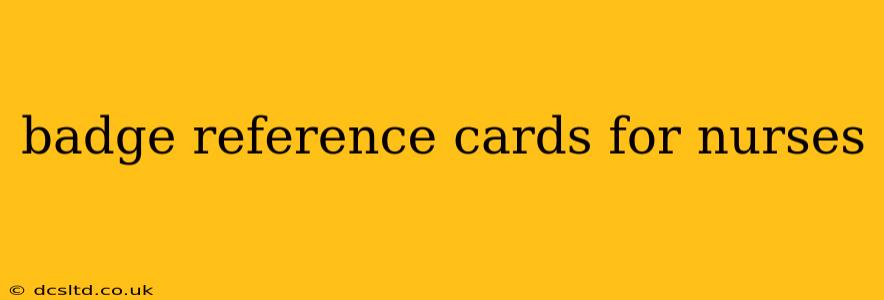Nursing is a demanding profession requiring quick access to critical information. Badge reference cards provide nurses with a readily available, concise summary of essential protocols, medications, and guidelines, enhancing patient safety and efficiency. This guide explores the benefits, creation, and best practices for designing effective badge reference cards for nurses.
What are Badge Reference Cards for Nurses?
Badge reference cards are small, durable cards clipped to a nurse's badge or identification lanyard. They contain condensed, essential information frequently needed during patient care. This might include medication dosages, emergency contact numbers, vital sign parameters, or quick-reference guides for specific procedures. Their purpose is to provide readily accessible information, minimizing the need to search for larger manuals or electronic devices during crucial moments.
Benefits of Using Badge Reference Cards
- Improved Efficiency: Quick access to vital information reduces search time, streamlining workflow and freeing up time for direct patient care.
- Enhanced Patient Safety: Immediate access to critical data, such as medication dosages or emergency protocols, can be crucial in preventing errors and responding effectively to emergencies.
- Reduced Errors: Clear, concise information minimizes the risk of misinterpretations and medication errors.
- Increased Confidence: Having readily available information boosts a nurse's confidence and competence, particularly in high-pressure situations.
- Consistent Practices: Standardized cards help ensure consistent application of protocols and procedures across the healthcare facility.
What Information Should Be Included?
The specific content of a badge reference card will vary based on the nurse's specialty and workplace. However, some common elements include:
- Emergency Contact Information: Internal and external emergency numbers (code blue, rapid response, poison control, etc.).
- Medication Dosages & Administration: Frequently administered medications with dosages, routes of administration, and potential side effects (always cross-reference with electronic medical records and medication administration records).
- Vital Sign Parameters: Normal ranges and critical values for vital signs (heart rate, blood pressure, respiratory rate, temperature, oxygen saturation).
- Procedure Guidelines: Short summaries of essential steps for common procedures (e.g., inserting IV lines, administering injections).
- Hospital-Specific Policies: Important guidelines and protocols specific to the healthcare facility.
H2: What information should NOT be included on a badge reference card?
It's crucial to understand what shouldn't be included to maintain patient privacy and accuracy:
- Patient-Specific Information: Never include any patient-identifiable data on the card.
- Detailed Medical Histories: Keep information concise and avoid lengthy descriptions.
- Unverified or Outdated Information: Ensure all information is up-to-date and verified by reliable sources.
- Complex Algorithms or Calculations: These are best handled with electronic tools to avoid errors.
H2: How to Create Effective Badge Reference Cards
The design of the card is crucial for readability and usability:
- Clear and Concise Language: Use simple, straightforward language, avoiding medical jargon where possible.
- Large, Legible Font: Choose a font size large enough for easy reading at a glance.
- Color-Coding and Highlighting: Use color-coding to highlight important information or categorize data.
- Durable Material: Select a durable, waterproof material that can withstand regular use and cleaning.
- Laminate for Protection: Laminating the card protects it from wear and tear and makes it easy to clean.
- Regular Review and Updates: Information on the cards should be reviewed and updated regularly to ensure accuracy and compliance with the latest guidelines.
H2: Are there legal considerations for using badge reference cards?
Yes, legal considerations are crucial. Ensure that the information provided is consistent with the facility’s policies, procedures, and all relevant legal and regulatory requirements. The information on the card should never replace official hospital policies, procedures, or training materials. It acts as a quick reference, not a standalone source of information.
H2: Where can I find templates or examples of nurse badge reference cards?
Many hospital systems and nursing organizations provide internal templates. You can also find examples online, but always remember to tailor any template to meet your specific institution's needs and guidelines. It's crucial to maintain compliance with local laws and regulations.
By carefully considering the content and design, nurses can create effective badge reference cards that enhance their efficiency, improve patient safety, and contribute to a more effective and confident work environment. Remember, these cards serve as a supplementary tool, not a replacement for comprehensive training and access to complete medical records.
